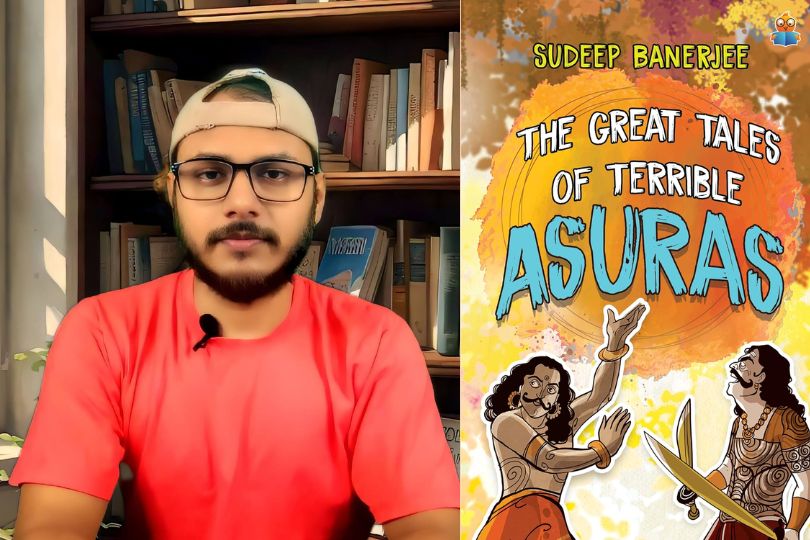Interview with Sudeep Banerjee Author of The Great Tales of Terrible Asuras
Explore Sudeep Banerjee's insights on mythology, focusing on Asuras' tales to inspire young readers with lessons on resilience, empathy, and humility.on Nov 07, 2024

About the Author
Sudeep Banerjee is a reader, writer and passionate weaver of stories. He is forever ready to get more knowledge of history and mythology, and loves writing for children. Apart
from writing, Sudeep loves spending time in the lap of nature, and enjoys cooking.
Frontlist: What inspired you to focus on the stories of the Asuras, often considered the antagonists in mythology? What drew you to these particular stories?
Sudeep: In my book, The Great Tales of Terrible Asuras, the stories are centered on the Asuras of mythology, and the prime thing that drew me to write these stories was the idea itself. You see, in most mythological narratives, we often find two things: first, every tale is mostly performed by the gods and goddesses, and second, Asuras are mostly portrayed as villains. However, the depths of their characters and the complexity they faced are rarely explored.
When studying mythology, we can't just stay on one perspective—we have to see both. Here, the Asuras, though considered antagonists in mythology, play a big role! They have their own motives, struggles, and ambitions that make them unique. And these stories, trust me, are important for young readers to understand that life isn't just black and white. It's more than that. There are many shades in between, and each character has their own story to tell.
Frontlist: The stories in your book emphasize timeless lessons such as perseverance, humility, and the dangers of arrogance. How do you see these ancient mythological teachings connecting with modern challenges?
Sudeep: Lessons are lessons, and teachings are teachings, whether based on ancient mythology or modern-day concepts. As far as mythological teachings are concerned, they fit into any era and offer guidance on facing challenges.
My stories highlight perseverance, humility, and the dangers of arrogance, which resonate with today's world. Perseverance teaches us to keep moving forward, no matter how tough the obstacles—a trait very much needed in today's fast-paced, competitive world. Humility teaches us that no matter how high we reach in success, we must stay grounded, as humility keeps us far from the arrogance of success. The dangers of arrogance are also highlighted, showing a society where leaders consumed by ego make harmful decisions, which we should avoid.
These stories teach children that regardless of the world's advancement, core values like character and self-awareness remain essential for personal growth and harmony.
Frontlist: What do you find most rewarding about crafting stories for young audiences, and what difficulties did you face when simplifying the mythology without losing its essence?
Sudeep: For me, the most rewarding aspect of crafting stories for young audiences is presenting them with the richness of the ancient mythological world. This allowed me to shape unique stories to align with young readers' understanding, incorporating values and morals. Children's curiosity is brimming, and these stories help them connect with their cultural roots in an engaging way, which I find immensely rewarding.
However, the biggest challenge was simplifying complex mythology without losing its essence. The Asuras' stories can be viewed from two angles—their wickedness and the philosophical ideas within. Making these stories accessible to children without diluting their core messages was difficult. I had to find a balance, making the stories engaging and understandable while preserving the depth and wisdom of the mythology.
Frontlist: Each of the stories offers moral takeaways for young readers. Could you elaborate on some of the key lessons you aimed to teach through the stories?
Sudeep: Truthfully, each story in this book is designed for readers to find moral takeaways that resonate with them. The first lesson is understanding both sides of a story. Asuras are often viewed as villains, but my aim here was to showcase their reasons for being perceived that way, their struggles, and their perspective. This teaches young readers about empathy and looking beyond labels.
Another key lesson is resilience. Asuras faced incredible challenges, and their stories show the importance of perseverance in adversity—a lesson valuable for all ages. Humility is also a major takeaway. Many Asura tales show how their downfall resulted from arrogance, pride, or greed. It teaches that true strength lies in humility.
Finally, the stories convey that every action has a consequence. The Asuras' choices, whether good or bad, led to their downfall or rise, teaching young readers about responsibility and accountability.
Frontlist: Through your journey as a writer, what are some of the most important lessons you've learned about storytelling and connecting with readers, especially children?
Sudeep: The most important lesson I've learned is the power of simplicity. When writing for children, I focus on conveying complex ideas and emotions in a way that young minds can grasp without losing engagement. Clear, relatable storytelling with vivid imagery is key, capturing their imagination.
Another lesson is the importance of emotional connection. Children connect deeply with engaging emotions, whether in a relatable world, characters, or moral dilemmas. Even mythology, when woven with fear, hope, and excitement, resonates with young minds. I've also learned that young readers value honesty in storytelling. Children are perceptive and can tell if a story feels forced or lacks authenticity.
Lastly, storytelling for children taught me the value of curiosity. Kids are inherently curious, so I aim to nurture their imagination and leave room for questions and exploration beyond the page.
Frontlist: As a lover of mythology, do you have a personal favorite mythological figure or tale, aside from those in your book?
Sudeep: Yes, I do have a favorite—Lord Sri Ram. He is more than just a mythological figure for me. If we set aside the depictions in serials and movies and view Sri Ram purely from texts, we see a life that wasn't all glory. Though he was born the eldest son of King Dasharath, he didn't inherit the throne. Instead of a golden palace, he spent years in the forest with Sita and Lakshman. Life in the forest wasn't comfortable as often shown; it was a harsh survival.
Then came Ravana, who kidnapped Sita. Ram could have summoned Ayodhya's army but instead befriended the Vanaras, whose help proved vital. Despite all his efforts, his life didn't end in joy. After returning to Ayodhya, he had to question Sita's purity to satisfy his subjects, leading her to Agni-Pariksha. Ram's life is filled with sacrifices, and despite it all, he remained calm and dutiful. This resilience and commitment to duty, prioritizing his people over personal happiness, is why I hold Lord Ram and the Ramayana close to my heart.
Frontlist: How do you see the role of mythological storytelling evolving in the future? With so many reinterpretations and retellings emerging, where do you think these timeless tales fit in our rapidly changing digital and modern landscape?
Sudeep: Mythology has a remarkable ability to adapt and evolve with time, which is why it remains relevant. The timeless themes—good vs. evil, courage in adversity, and the quest for purpose—resonate across generations, regardless of technological advancement.
Today, with numerous reinterpretations and retellings, mythological storytelling is transforming. New media—films, graphic novels, video games—present ancient tales in fresh, creative formats, making them accessible to younger audiences. These transformations blend ancient wisdom with modern challenges, and the beauty of mythology is that its core essence remains intact, even when told through different lenses.
Mythology plays a vital role in literature and serves as an educational tool that connects us to our roots. As long as we find meaning in mythology and its teachings, these tales will continue to evolve and inspire, seamlessly fitting into both present and future landscapes.



.jpg)






.jpg)

.jpg)
.jpg)
.jpg)
.jpg)
.jpg)










Sorry! No comment found for this post.